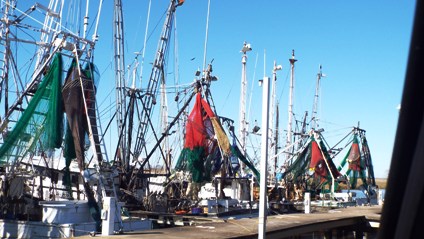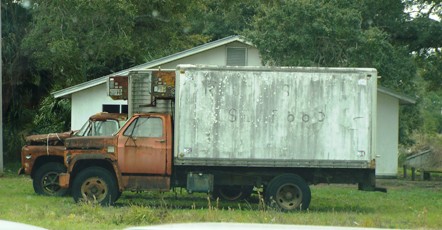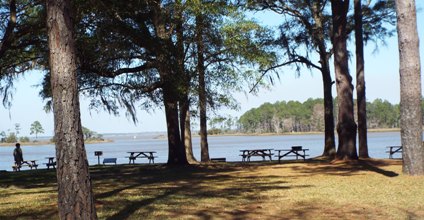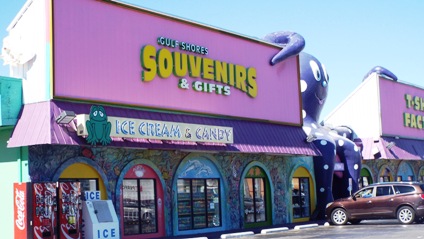A relatively
last minute decision after Christmas found us looking for warm weather and a
change of scenery. Mike ferreted out available RV spots along Florida's
"Forgotten Coast." So with
reservations at Dr. Julian G. Bruce State Park on St. George Island, off of Apalachicola,
Florida; at Topsail Hill Preserve State Park near Destin; and at Gulf State
Park in Orange Beach, Alabama, we packed up the RV, snatched up Sophie, the
little white dog, and headed south toward the Gulf of Mexico.
 |
| This Great Blue Heron was waiting for us on St. George Island |
St.
George Island is reached by a five-mile-long causeway from East Point, Florida. The cozy campground in an otherwise sprawling
park is situated between the bay and the ocean.
Easy access to the beach and an abundance of shells on the beaches are
major pluses. The park encompasses the
entire east end of the island. The
remainder of the island consists of summer homes, a few local eateries, and the
light house, situated roughly in the center of the 15-mile long island, where
the causeway from the mainland terminates.
Restaurants, boutiques, and local museums are located twenty minutes
away in the small but welcoming seafaring town of Apalachicola. The Dr. John Gorrie Museum, though small, is
noteworthy because it features the first ice machine ever designed. Gorrie's
attempts to relieve those suffering from malaria and yellow fever led him to
design and build a machine that cooled patients' rooms. As a side benefit, the machine produced ice.
 |
The "bay side" of the island, looking toward the mainland.
This spot was just a short walk from our camp site. |
 |
| The "gulf side" of St. George Island on a day in early February |
 |
After standing for 153 years, the 72-foot Cape St. George Light toppled into the
sea in October 2005. The pieces were salvaged and the light was rebuilt in 2008 |
 |
| The marshes on the bay side of St. George Island on a foggy morning |
 |
Yvonne loved walking on the beach on St. George
Island. This was taken late in the afternoon. |
 |
| Some of the hundreds of seashells that she collected |
 |
| A three-quarter-sized replica of Dr. John Gorrie's ice machine |
Two
historical homes are open for tours. The
Orman House was built in 1838 by Thomas Orman, a cotton merchant. The David G. Raney House (also 1838) is a
beautiful antebellum house that is on the National Register of Historic Places.
 |
David Raney's home was a composit of two styles that were
popular in the South when it was built in 1838: Federalist and
Greek Revival. Raney made his fortune as a cotton trader. |
 |
Members of the Raney family continued
to live in the house until 1914 |
 |
Raney's son, David Raney Jr. distinguished himself in the
Civil War, commanding the Marines aboard the Confederate
ironclad C.S.S. Tennessee in the Battle of Mobile Bay |
 |
| Fishing fleet tied up at the pier in the Apalachicola River |
 |
| Colorful nets adorn the fishing and shrimping boats |
 |
Old, abandoned refrigerated trucks that once
belonged to Water Street Seafood, Inc. |
While we
were there the town hosted a lively pet parade in conjunction with Mardi Gras. This year's parade theme was "Woofstock"
and all the participants, two legged and four, decked out in bell bottoms,
tie-dyed shirts and, of course, beads, seemed to enjoy the festivities.
 |
Small-town festivals and parades give you a chance
to get the real "flavor" of an area |
 |
We had the feeling that some of the two-legged participants
were not too far removed from the original Woodstock |
 |
| Mike and Sophie watch the parade on a cool Saturday morning |
 |
Hooked up and ready to leave St. George Island. This picture was taken
from the deck of a restroom/shower house on the beach in the state park. |
Moving
west along the coast, our next stop was Topsail Hill Preserve State Park. Our full-hook-up site, located on a small
lake, was about a twenty-five minute walk or a six minute tram ride - tram service is
provided by the park on an hourly basis - from the white sugary beaches for
which Destin is known. The temperatures in the high sixties were warm enough
for walking on the beach but not for sitting on the beach reading a book. But the area offered plenty of shopping and (as
always) eating destinations. Local communities such as Watercolor and Seaside
offered picturesque settings and opportunities for browsing. Excursions out of town included Eden Garden
State Park which features the Wesley Homestead and the historic town of
DeFuniak Springs. DeFuniak Springs was
the "winter home" of the Chautauqua educational movement, founded on
Lake Chautauqua in New York state late in the 19th century.
 |
Sunset over the little lake that was the backdrop for our
camp site at Topsail Hill State Park near Destin |
 |
In the little town of Seaside, a group of old Airstream trailers
has been re-purposed as a food court along the main street |
 |
The Seaside, Florida Post Office...a whole bunch of P.O. boxes, one
service window, and just enough room to step inside to get your mail |
 |
Dune Allen Beach, just east of Topsail Hill State Park. The day we were
here, a group of runners had just finished a 30-mile run in the sand |
 |
The Wesley house in Eden Gardens State Park, an 1895 mansion known for
its Louis XVI furniture...but the furniture was all added in a 1963 remodel |
 |
The Wesleys were in the lumber business. They had several sawmills built on
pilings in the back bay, so they could float logs in and ship cut lumber out |
 |
| Eden Gardens State Park is noted for its extensive and beautiful camellia beds |
 |
The Chautauqua Hall of Brotherhood included a 4,000 seat auditorium that
hosted seminars and classes for teachers on "vacation" in DeFuniak Springs |
 |
| DeFuniak Springs is filled with great old Victorian-style homes |
 |
What a juxtaposition...a late 19th century building, and three 21st
century Tesla charging stations on a street in DuFuniak Springs |
Continuing
west along the coast we were fortunate to get a lakeside site at Gulf State
Park, situated between Orange Beach and Gulf Shores, Alabama. This park, as well as the previous two parks,
offered extensive bicycle trails; next time, we will bring the bikes along. The weather, while mostly pleasant, was temperamental.
One night the emergency weather radio that we keep in the RV and Mike's phone
simultaneously advised us to "take immediate shelter". The campground
is very large, with over four hundred sites, so there are a number of concrete
bathhouses throughout the park. We
gathered up Sophie and headed to the nearest bathhouse to wait out the storm
and possible tornados. Eventually there
were about a hundred people, twenty dogs and one intimidated cat sheltered
together. After about an hour the immediate
danger was over, though the winds gusted twenty-five to forty miles per hour
all night. Some thirty miles away several tornadoes did touch down, including
one that struck part of Pensacola, Florida, so it is always best to take
precautions.
 |
| The beach at Gulf Shores, Alabama |
 |
Our site at Gulf State Park was right on one of two lakes in the
park, one of which is in the approximately 400 space campground. |
 |
About 10 days until the "spring breakers" arrive, and stores were
stocking their shelves with everything for the new season |
 |
Probably the largest souvenir store in Gulf Shores,
dating back to 1956. Enter through the shark! |
 |
The HANGOUT, a large restaurant/bar/entertainment complex right on the
beach in Gulf Shores, features an extensive collection of PEZ dispensers |
The
ocean and the pier -- the second-longest pedestrian and fishing pier extending into the
Gulf of Mexico -- offer relaxation and fishing opportunities. Tourist shops,
restaurants and bars were gearing up for the onslaught of spring breakers.
 |
The original pier, at a mere 750 feet long, was destroyed by Hurricane Ivan in 2004.
The new pier, built several years later, at 1,540 feet, is more than twice as long. |
 |
The beach at Gulf State Park, looking east from the fishing pier.
The multi-story condos in the distance are in Orange Beach, AL. |
 |
| "Mother, Mother Ocean, I have heard your call..." ~ Jimmy Buffett |
 |
A Great Blue Heron pays scant attention to the
tourists snapping his picture on the pier |
One day
we took the ferry over to Dauphin Island, one of the barrier islands located at
the mouth of Mobile Bay. Fort Morgan on
the peninsula and Fort Gaines on Dauphine Island, with six miles of water
between them, were constructed to guard the mouth of the bay It was here, while running the blockade
during the battle of Mobile Bay in 1864, that Admiral Farragut issued his
famous statement "Damn the torpedoes, full speed ahead." In addition to Fort Gaines, Dauphin Island is
also home to the Dauphin Island Sea Lab Estuarium, Alabama's primary marine
education and research center, offering insights into the bay, river delta,
Gulf of Mexico, and island habitats and ecosystems that make up the area.
 |
The ferry passes a natural gas drilling rig in Mobile Bay. In areas not
dredged for shipping channels, the bay averages only 10 to 15 feet deep |
 |
Fort Gaines on the west side of the mouth of the bay, sits right
at the water's edge. Six miles across the bay is Fort Morgan |
Another
excursion took us to Foley, Alabama where we enjoyed visiting the Holmes Medical
Museum, housed in Baldwin County's first hospital (c. 1936) and the Baldwin
County Heritage Museum. At the Heritage
Museum, we were fortunate enough to hear a speaker whose specialty was the
history and social significance of flour/feed sacks.
 |
Operating room and operating table at the Medical Museum
in Baldwin County's first hospital in Foley, AL |
 |
Baldwin County Historical Museum's display of quilts
and clothing made from original feed and flour sacks |
A
30-mile jaunt back into Florida one day took us to Pensacola Naval Air Station
(NAS) for an enjoyable and very informative tour of the National Aviation
Museum. Well to be honest, Mike soaked up all the information he could from a
retired Marine aviator while I wandered around the museum taking pictures. We
joined up later for lunch at the Cubi Bar Cafe. U.S. Naval Air Station Cubi Point was a Navy
aviation facility located at the edge of Naval Base Subic Bay. After
the U.S. base was closed in the Philippines, the Officers' Club and all the memorabilia
was relocated intact to the National Aviation Museum. Visiting the Cubi Point
"O" Club is a thrill as you immerse yourself in history and wonder
about the lives of the flyers who visited the club.
 |
| Blue Angels F/A-18 Hornet once piloted by Major Brent Stevens |
 |
In 1946, this plane, the "Truculent Turtle", carrying a crew of four and 8,467
gallons of gas, set a new record of 11,235.6 miles and 55 hours 17 minutes of
continuous flight without refueling, between Perth, Australia and Columbus, Ohio |
 |
This helicopter served as Marine One when Richard M. Nixon was President,
and flew him to and from the White House grounds and Andrews AFB |
 |
By the fall of 1992, the U.S. had withdrawn its forces from
Subic Bay and Cubi Point, and the Officers' Club was dismantled
and moved to the National Naval Aviation Museum |
 |
The club is filled with signs, plaques and squadron
memorabilia from the crews stationed at Cubi Point |
We left
St. Louis looking for warm weather and a change of scenery. And no matter where you go, you are likely to
find plenty of interesting Road Stories.
 |
We had a great time in Florida and Alabama.
Thanks for reading our blog. ~ Sophie |
